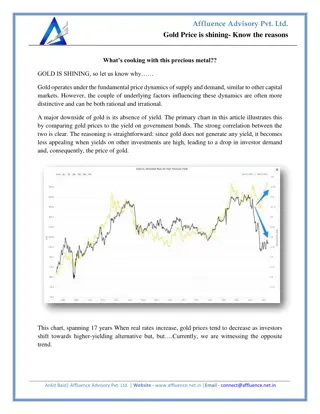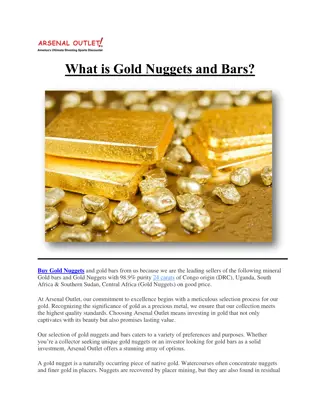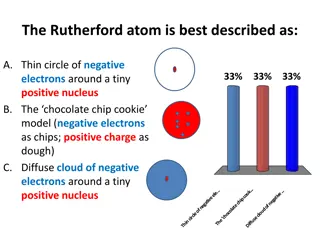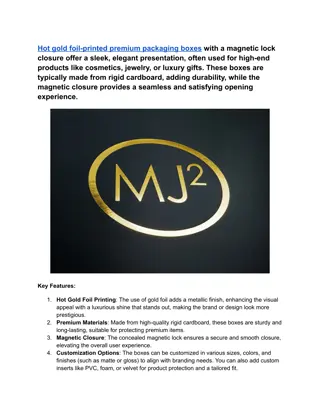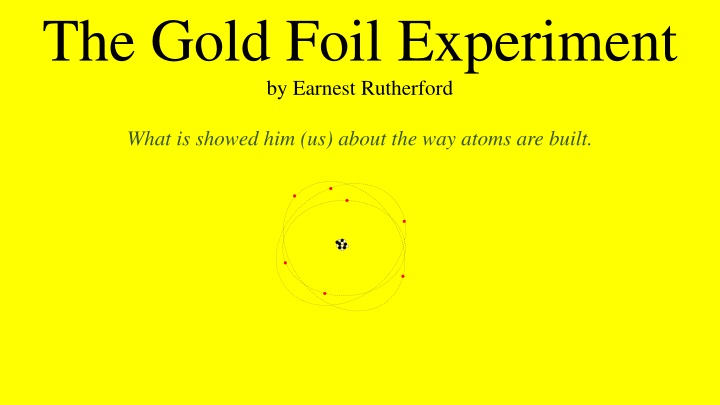
Revealing the Structure of Atoms: The Gold Foil Experiment by Earnest Rutherford
Discover how Earnest Rutherford's Gold Foil Experiment revolutionized our understanding of atomic structure. Explore the impact of alpha particles on a gold foil, highlighting the breakthrough insights gained from this groundbreaking experiment.
Download Presentation

Please find below an Image/Link to download the presentation.
The content on the website is provided AS IS for your information and personal use only. It may not be sold, licensed, or shared on other websites without obtaining consent from the author. If you encounter any issues during the download, it is possible that the publisher has removed the file from their server.
You are allowed to download the files provided on this website for personal or commercial use, subject to the condition that they are used lawfully. All files are the property of their respective owners.
The content on the website is provided AS IS for your information and personal use only. It may not be sold, licensed, or shared on other websites without obtaining consent from the author.
E N D
Presentation Transcript
The Gold Foil Experiment by Earnest Rutherford What is showed him (us) about the way atoms are built.
Radioactive polonium metal in a lead box. The polonium emits alpha particles, with mass of 4 amu and charge of +2. They are aimed at the gold foil. Here only one atom of the foil is in the diagram, but it s enough to learn how this works. Polonium
The alpha particles are emitted constantly at the same rate, and can be detected, if they hit a screen that is coated by zinc sulfide (ZnS). A little flash of light can be seen with your eyes. Polonium
Where an alpha particles hits the screen, a little flash of light can be seen. Polonium
This happens over and over, as if ALL of the metal is not really there. The alpha particles just go through the foil. Here the alpha particles go through just one atom. Polonium
Again Polonium
Sometimes an alpha particle appears to be sent off at a wide angle, as if it HIT something bigger that diverted it. Polonium
But most alpha particles seem to fly right through the foil, hitting the screen straight on. Polonium
Scientists can count the flashes, that match the rate of flashes when the foil is taken away from the experiment. Over and over. Polonium
Like a clock, all the alpha particles go through the foil (here it is just one atom). Polonium
Rarely it seems that an alpha particle is bounced BACKWARDS (the red line here) Polonium
The early model of the atom, by John Dalton (who did give us the atomic theory) had described atoms in a sort of simple way. Dalton atom model He said that atoms were hard spheres (the gray here), where the mass of the atom was, and were neutral. The black lines represent what alpha particles would do when shot at atoms built like this. All the alpha particles should bounce off the foil, if atoms were built like Dalton described. Atomic foil
The next model of the atom, by JJ Thomson (who did discover the electron and who was brilliant beyond words) had described atoms in a sort of funny way. Thomson atom model He said that atoms were composed of positive stuff (the orange here), with electrons imbedded into it. The black lines represent what alpha particles would do when shot at atoms built like this. All the alpha particles should fly right through the foil, if atoms were built like this.
Since that is NOT what the alpha particles did in the gold foil experiment, Rutherford imagined the atoms having a volume made up of the negative electrons flying around a small dense center, which contained nearly all the atom s mass and positive charge. Thomson atom model Rutherford atom model The balance of charges kept atoms neutral (which they seemed to be and are), but this explanation allowed Rutherford to explain why alpha particles were sometimes sent unexpected, odd angles.
The positive alpha particles banged into much larger positive nuclei, but not often. When they did, they were given a bump at an angle. Rutherford atom model Rarely the alpha particles hit straight on, and the alpha particles were bounced backwards.
Rutherford concluded this. 1. Atoms are mostly empty space (the electrons fly around a very small dense, positive nucleus. 2. The Nucleus contained nearly all of the mass of an atom. 3. The electrons made up nearly all of the volume of an atom 4. The positive and negatives were equal, the atoms were neutral. 5. The alpha particles flew easily through the atoms, unless they happened to clip a nucleus. 6. Depending upon the ding , alpha particles could be diverted from the straight path they were on, or even reversed! 7. Somehow the electrons stayed in orbit around the nuclei, in some ways like planets stayed in orbit around the Sun. 8. Although that was (is) true, it was very hard to prove, and Rutherford could not do it himself, he had help from Neils Bohr.
In this diagram, all the alpha particles are coming from the LEFT, shooting at a sheet of gold atoms only one layer thick (for diagrammatic purposes, it s too thin to exist). It shows how MOST alpha particles travelling in line with the BLUE LINES, go straight through the atoms. Some are deflected, some that hit a nucleus of a gold atom. In this diagram, no alpha particles are bounced in reverse. Electron Shell = Electron Orbitals
This is but a single atom of gold, with many alpha particles (the black lines) going right through it -- as if it weren t even there. The reason so many alpha particles miss the nucleus, it s said that if the nucleus were the size of a period at the end of this sentence, the volume of the atom is about the size of your house. I realize that this is hard to grasp, but it s true. And that is why 99% of the alpha particles have no trouble getting through a many atoms thick layer of gold foil. However thin you can imagine that, most likely at least 100 s of atoms thick.


